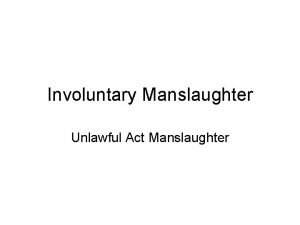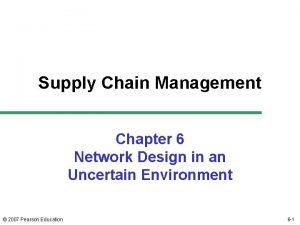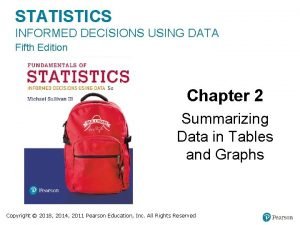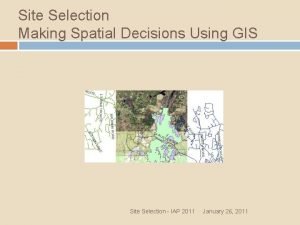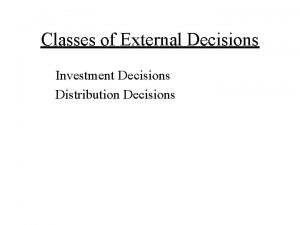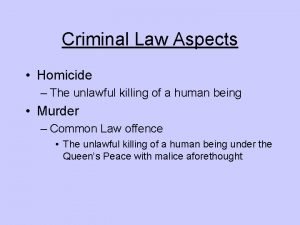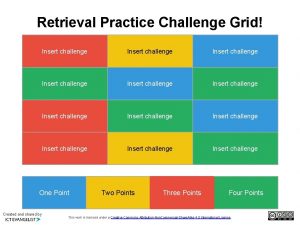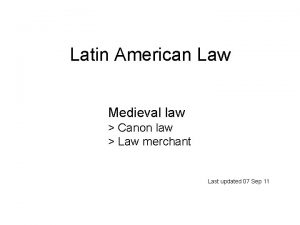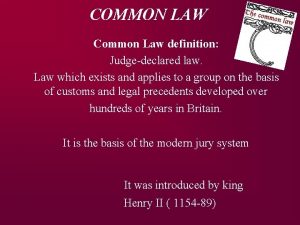USING THE LAW TO CHALLENGE UNLAWFUL DECISIONS PRACTICAL













![1. The Isle of Wight Judgment - [2011] EWHC 2911 • Isle of Wight’s 1. The Isle of Wight Judgment - [2011] EWHC 2911 • Isle of Wight’s](https://slidetodoc.com/presentation_image/4c56fbecb6bfa364b1eab5d4ebd3d51d/image-14.jpg)
























- Slides: 38

USING THE LAW TO CHALLENGE UNLAWFUL DECISIONS: PRACTICAL CONSIDERATIONS Alex Rook Associate Solicitor, Public Law Department Irwin Mitchell LLP

Summary 1. Who can bring the challenge, and how to fund it 2. How to challenge decisions by public authorities 3. Case Studies

Background • We all understand that times are tough, and that the pressure on local authority and PCT funds is significant. • That having been said, local authorities and PCTs need to make the tough decisions on funding, looking at what is in the individual’s best interests and with the legal duties as set out firmly in mind – otherwise the ‘law’ of unintended consequences is very likely to apply.

1. Who is the Claimant? • Who can advocate and support bringing the challenge? 1. An individual claimant (via a litigation friend) or a family member 2. An organisation in its own name 3. Somebody with no connection to the case but where subject matter is of wider interest to the organisation which decides to “intervene”.

1. Individual claimant • Legal Aid certificate for affected individuals whose means qualify. If a child, the means are the child's if need to bring the matter before the court, but could be the parents/carers for initial investigations – Gives valuable protection against an adverse costs order if some part of whole of the action is lost – But may be subject to a financial contribution from “community” where there are ‘other persons or bodies who might benefit from the proceedings and can reasonably be expected to fund the case’ – Family member can bring the action on behalf of the claimant (who may themselves qualify for legal aid • Conditional Fee Arrangements? Rare but possible, and discounted and blended fees used

2. Organisation • • Key issue: – Does the proposed action further the interests of the organisation? – Whose approval needs to be obtained Does the organisation’s constitution allow public interest legal action to be taken? Is it within the organisation’s objects i. e. – In the Memo and Articles of Association for a company – In the Trust Deed or Rules for an unincorporated body – In the Charter for a body incorporated by charter (some professional bodies) Charities – Follow Charity Commission guidance (see overleaf)

Organisation cont. • Limiting exposure of the officers of the organisation - Insurance (Directors and Officers/Trustees) - Indemnity from the organisation itself - Under S. 29 Charities Act 1993 Advice from Charity Commission gives protection to Trustees from personal liability for costs, if satisfied that proposed action is: - Proportionate - Appropriate - Reasonable use of charitable funds - Good prospects of success

Organisation Cont. • Limiting exposure of the organisation itself - Insurance against adverse costs (ATE) - Protective Costs Orders (PCO) - Still a developing concept. In essence it means that the Court orders a limit to costs recovery early on in the case, certainly for the Claimant organisation but possibly for both sides. - Means that regardless of the outcome of the case, there is certainty as to the ‘worst case scenario, ’ but there may still be the possibility of recovering all or part of the costs incurred from the other party.

3. Intervening • “Intervention” can be a cost effective way of getting a campaigning organisation’s views across at virtually no costs risk - by written submissions - or additionally orally through an advocate

2. How To Challenge Decisions by Public Authorities • National charities – help families understand their rights/the law and push cases forward at the right time • Parent / local groups – hopefully understand the basics and use it in your local lobbying – Consider a complaint if time is not a factor - perhaps in tandem with making initial enquiries but don’t delay! At the end of the complaints process if still dissatisfied clients can go to the Ombudsman. – If you have reached the end of this process and are still dissatisfied with, for example, an ongoing failure, or if this is an urgent matter, Judicial Review is the ‘remedy of last resort’. This is particularly relevant if the lack of care presents an immediate risk to the individual’s health and well being.

Judicial Review To Obtain Statutory Services • Procedure by which High Court reviews lawfulness of decisions made by public bodies. • Identify decision: What? Who? When? NB Time limits 3 months. • Find document recording decision: letter / minutes / tribunal decision. • Final decision? All rights of appeal / review exhausted? • Is there an urgent need for remedy? • Grounds broadly limited to - acting outside or beyond powers given (ultra vires) - acting irrationally or perversely - procedural impropriety

Some Points For Judicial Review Cont • Victory will lead to the decision being overturned • Often negotiations during litigation may get you the result you want • NB: overturning the decision may still mean that if the public body takes the decision again, it reaches the same conclusion that you objected to in the first place

Case Studies • 1. Challenge to Isle of Wight’s policy towards adults in need of social care • 2. Challenge to the legality of the consultation undertaken by the London Borough of Hillingdon to close 3 adult learning disabled day centres • 3. Challenge to the amendment by West Berkshire Council to their charging policy
![1 The Isle of Wight Judgment 2011 EWHC 2911 Isle of Wights 1. The Isle of Wight Judgment - [2011] EWHC 2911 • Isle of Wight’s](https://slidetodoc.com/presentation_image/4c56fbecb6bfa364b1eab5d4ebd3d51d/image-14.jpg)
1. The Isle of Wight Judgment - [2011] EWHC 2911 • Isle of Wight’s decision • The Claimants • Grounds of challenge • Defence • Judgment • The implications…

Isle of Wight Council’s decision • Decision to reduce budget for adult social care by restricting support for people with disabilities to those assessed as being “critical” and “those people who are assessed to have needs defined as substantial who are at the greatest risk of not being able to remain at home and be safe. ” • Decision taken pursuant to business plan and proposed budget for 2011 -2012 to change eligibility criteria for providing support to meet the needs of disabled people. • National guidance (“Fair Access to Care Services” or “FACS”) provides for needs to be assessed as low, moderate, substantial or critical. • Previously, IOW provided support for people assessed as substantial or critical

The Claimants • Two claimants, both severely disabled adult residents of Isle of Wight. • JM: aged 32. He has severe autism and a brain injury acquired at birth. He lives with his parents who are retired and ‘devote their lives to his care’. He needs support and supervision throughout the day and would be extremely vulnerable if left unattended. • NT: aged 31. He has autism and a learning difficulty. Since 2000 he has lived in residential accommodation provided by the defendant during the week, but returns home to his mother every weekend. Although he can attend to many of his basic needs he is highly vulnerable and requires support with cooking, shopping and taking medication. • As recipients of adult social care services from the Council, both had a direct interest in the decisions challenged, one of who had not been reassessed under the new policy.

Grounds of challenge • The Claimants claimed the Defendant acted unlawfully by: i. Failing to comply with the requirements of the statutory guidance governing the provision of adult social care; ii. Failing to comply with the public sector equality duty in the Disability Discrimination Act 1995, s. 49 A. This encompassed an argument that the consultation itself was flawed.

Equality Act 2010 • Brings together 9 separate pieces of legislation into one act to tackle inequality – including Disability and Sex Discrimination and Race Relations Act. • Refers to protected characteristics (S 4) – age, disability, gender reassignment, marriage/civil partnership, pregnancy, race, religion, sex or sexual orientation. • Key piece of legislation to challenge the lawfulness of the cuts

Public Sector Equality Duty • Section 149(1) introduces three equality aims: A public authority must, in the exercise of its functions, have due regard to the need to: - (a) Eliminate discrimination, harassment, victimisation and any other conduct that is prohibited by or under this Act; (b) Advance equality of opportunity between persons who share a relevant protected characteristic and persons who do not share it; (c) Foster good relations between persons who share a relevant protected characteristic and persons who do not share it (new)

Purpose of the Equality Duty cont. . • The second aim (advance) imposes most onerous duty – see s 149(3) need to— (a) remove or minimise disadvantages suffered by persons who share a relevant protected characteristic that are connected to that characteristic; (b) take steps to meet the needs of persons who share a relevant protected characteristic that are different from the needs of persons who do not share it; (c) encourage persons who share a relevant protected characteristic to participate in public life or in any other activity in which participation by such persons is disproportionately low.

Purpose of the Equality Duty • EHRC Guidance ‘The essential guide’ at p 6 states: The broad purpose of the equality duty is to integrate consideration of equality and good relations into the day-to-day business of public authorities. If you do not consider how a function can affect different groups in different ways, it is unlikely to have the intended effect. This can contribute to greater inequality and poor outcomes. The general equality duty therefore requires organisations to consider how they could positively contribute to the advancement of equality and good relations. It requires equality considerations to be reflected into the design of policies and the delivery of services, including internal policies, and for these issues to be kept under review.

Grounds of challenge What does the duty entail? • May require positive steps to be taken if the circumstances require it to address disadvantage to disabled people; • If changing a function or proposed policy would lead to significant benefits to disabled people, the need for such a change will carry added weight when balanced against other considerations; • If a risk of adverse impact is identified, consideration must be given to measures to avoid that impact before fixing on a particular solution; • Impact assessments must contain sufficient information to enable a public authority to show it has paid due regard to the duty and identify methods for mitigating or avoiding adverse impact;

The Defence • IOW argued that it was clear from the evidence that the Council were ‘fully aware of their obligations’ • Argued that the existence of an equality impact assessment was itself ‘very strong evidence that due regard was had’ • Permissible for the assessments to be ‘couched at a fairly high level of generality’ as they would be undertaking reassessments looking at individual needs. • That the Claimants were being ‘pernicious’ in bringing the claim • In essence, IOW submitted that it had identified and considered what alternative courses of action available and their implications, the nature and extent of the impacts and how those impacts to be addressed and mitigated.

Judgment • Mrs Justice Lang held that: - • Court's role to assess whether IOW complied with duty under s. 49 A DDA • “the consultation document provided insufficient information to enable those consulted “to give intelligent consideration and an intelligent response. . . Unfortunately it did not provide any detail about the numbers of users whose support would be reduced, not even giving the figures which were provided in the report to Cabinet on 14 September 2010 (see paragraph 20 above). It did not give any detail about the costs and potential savings. Nor did it explain what types of services would or would not be included under the revised criteria. Consultees, including the parents of the Claimants, were left uncertain as to what impact the revised criteria would have on the assistance they received from the Council. ” • The Council did not even comply with its own guidance on equality impact assessments. • ‘The problem caused by the lack of detail about the proposals was exacerbated by the vagueness of the proposals themselves’

Judgment • “Where, as here, a council was considering provision for the disabled, it was self evident that it would have the needs of the disabled in mind. However, I endorse the observation of Walker J in R (W) v Birmingham City Council, when he said, at [179]: I readily accept that throughout the process the Council was giving consideration to how to address the needs of the disabled. In that sense its decisions taken in relation to adult social care were decisions which were relevant to its performance of the s. 49 A duty. That is not the same thing, however, as doing what s. 49 A seeks to ensure: namely to consider the impact of a proposed decision and ask whether a decision with that potential impact would be consistent with the need to pay due regard to the principles of disability equality. . ” • For the reasons set out above, the Council did not conduct the rigorous analysis and consideration required in order to satisfy the ‘due regard’ duty under s. 49 A DDA 1995, principally because it did not gather the information required to do so properly. ”

2. Hillingdon Day Centres • 3 Claimants, each of whom are disabled adults who live in Hillingdon. All three of them are in their mid-40’s and live at home and are cared for by their respective families. • They currently attend one or other of three day centres in Hillingdon (Phoenix, Woodside or Park View) all day 5 days per week. This is a service that they rely upon to meet their assessed needs, and which provides their parent/carers with some much needed respite. • Judicial Review proceedings were brought to challenge Hillingdon’s decision of 26 January 2012 to close three day centres and, instead, open a new facility (offering many fewer places) at Queenswalk.

Hillingdon Day Centres • It was argued that the decision taken by Hillingdon in January 2012 was unlawful because: (a) The consultation on which it relied did not meet the basic requirement that consultees must be provided with sufficient information to respond meaningfully to what is being proposed. (b) Councillors did not have or obtain sufficient information about the impact of what was being proposed when they took their decision. (c) There was an absence of any meaningful information about how what was proposed would impact on disabled people such that the Council did not lawfully discharge the public sector equality duty (PSED).

Hillingdon Day Centres In particular it was argued that the Equality Impact Assessment (EIA): 1. Contained no evidence-based information about the specific impact on disabled people of the proposals; 2. Did not explain the nature of the needs of people who would lose services, 3. Did not explain what the detriment would be to disabled people; 4. Did not state how many disabled people would be detrimentally affected; and 5. The suggestions in the EIA for mitigating the effects of the proposal were accordingly made without a proper understanding of the potential detriment.

Hillingdon Day Centres • On 25 July 2012, HH Judge Birtles QC sitting as a Deputy High Court Judge in the Administrative Court granted permission for that challenge on all 3 grounds of claim. • Hillingdon shortly afterwards agreed that it will consider afresh the question of whether to decommission the three day centres, and the Judicial Review proceedings were withdrawn. • Hillingdon commenced new consultation on 1 November 2012 which will consult again on the proposals, having undertaken a number of steps including an assessment of the needs of those affected. .

3. West Berkshire Charging policy • Assessment – s 47 NHSCCA 1990 • LA absolute duty to meet eligible needs • Financial assessment should only take place after assessment of need • Services should not be delayed to await financial assessment (Prioritising Need)

Social care services – who pays? • LAs have the power to charge for services • No presumption in law that they should charge – but many LAs are now charging • Legal framework in Health and Social Services and Social Security Adjudications Act (HASSASSA) 1983 and Fairer Charging Guidance • Not included: after-care services provided under section 117 of the Mental Health Act • Provision of advice about the availability of services or for assessment, including assessment of community care needs.

Paying for social care services – the law • Health and Social Services and Social Security Adjudications Act (HASSASSA) 1983. • Section 17(1) – a local authority “may recover such charge as it considers to be reasonable. ” • S 17(3) - where a person’s means are insufficient for it to be reasonably practicable for her to pay for the service there shall be no such charge

Paying for social care – the law (2) • Fairer Charging Policies for Home Care and other nonresidential Social Services: Guidance for Councils with Social Services Responsibilities • LAs must follow Guidance unless there is good reason not to do so – see R v Islington London Borough Council, Ex p Rixon (1998) 1 CCL Rep 119, 123 J-K • Where they do decide to charge for services, councils also retain substantial discretion in the design of charging policies.

Paying for social care services - the financial assessment • Where Councils assess disability related benefits as part of a person’s net income: ‘Councils are expected to assess disabilityrelated expenditure specifically for all users whose disability- related benefits are taken into account as income. ’ • LAs must base their assessment on persons’ income less disability related expenditure (DRE) • Councils should ensure that comprehensive benefits advice is provided to all users at the time of a charge assessment. Councils have a responsibility to seek to maximise the incomes of users, where they would be entitled to benefits, particularly where the user is asked to pay a charge.

Paying for social care • “The overall aim should be to allow for reasonable expenditure needed for independent living by the disabled person. Items where the user has little or no choice other than to incur the expenditure, in order to maintain independence of life, should normally be allowed” • the process of assessment and claiming for items of disabilityrelated expenditure should not be made unduly complex, particularly for users without high care needs. The process should not be primarily paper based, or carried out by post as a full list of possible items without explanation could be confusing for users. ……users will very often need personal help and advice on how to claim. Assessments involving disability related expenditure should, therefore, normally be carried out by personal interview in the user’s own home. • LAs must leave net income of income support plus 25%

Case study – West Berkshire • Judicial review of West Berks’ policy • Acted for 3 disabled adults • Challenged West Berks’ policy on the grounds that it was unlawful as: v WB would only take into account DRE where expenditure related to an ‘eligible need’ v WB has a policy of only meeting ‘critical’ needs – so a double detriment to disabled service users! v Policy also failed to allow items on the Fairer Charging list as DRE v West Berks initially defended the claim, but conceded and policy has been amended after proceedings were issued v Which other councils have adopted a similar policy?

Charging – issues to look out for • Not taking into account DRE/using flat rates to assess DRE • Failing to take into account DRE referred to in the Fairer Charging Guidance • Flat rate charges for services • Lack of individual assessments by personal interview (though would need to show detriment to service user if a challenge is to be brought) • Failure to allow the LA discretion to waive charges where not reasonably practicable for the individual to pay • Failure to leave individual with net income of income support plus 25% - this sum will vary

Public Law Department Web : www. irwinmitchell. com/servicesforyou/adminpubliclaw Email: alex. rook@irwinmitchell. com Telephone: 0207 421 3907
 Good decision making poster
Good decision making poster Unlawful act manslaughter definition
Unlawful act manslaughter definition Examples of involuntary manslaughter
Examples of involuntary manslaughter Screening decisions and preference decisions
Screening decisions and preference decisions Welcome to teen challenge uk - teen challenge uk
Welcome to teen challenge uk - teen challenge uk Network design decisions using decision trees
Network design decisions using decision trees Statistics informed decisions using data 5th edition pdf
Statistics informed decisions using data 5th edition pdf Making spatial decisions using gis
Making spatial decisions using gis Newton's first law and second law and third law
Newton's first law and second law and third law Si unit of newton's first law
Si unit of newton's first law V=k/p
V=k/p P=k/v
P=k/v Other practical applications of boyle's law
Other practical applications of boyle's law Brelate
Brelate Hình ảnh bộ gõ cơ thể búng tay
Hình ảnh bộ gõ cơ thể búng tay Lp html
Lp html Bổ thể
Bổ thể Tỉ lệ cơ thể trẻ em
Tỉ lệ cơ thể trẻ em Voi kéo gỗ như thế nào
Voi kéo gỗ như thế nào Tư thế worms-breton
Tư thế worms-breton Hát lên người ơi
Hát lên người ơi Môn thể thao bắt đầu bằng từ đua
Môn thể thao bắt đầu bằng từ đua Thế nào là hệ số cao nhất
Thế nào là hệ số cao nhất Các châu lục và đại dương trên thế giới
Các châu lục và đại dương trên thế giới Công thức tiính động năng
Công thức tiính động năng Trời xanh đây là của chúng ta thể thơ
Trời xanh đây là của chúng ta thể thơ Mật thư anh em như thể tay chân
Mật thư anh em như thể tay chân Phép trừ bù
Phép trừ bù độ dài liên kết
độ dài liên kết Các châu lục và đại dương trên thế giới
Các châu lục và đại dương trên thế giới Thể thơ truyền thống
Thể thơ truyền thống Quá trình desamine hóa có thể tạo ra
Quá trình desamine hóa có thể tạo ra Một số thể thơ truyền thống
Một số thể thơ truyền thống Bàn tay mà dây bẩn
Bàn tay mà dây bẩn Vẽ hình chiếu vuông góc của vật thể sau
Vẽ hình chiếu vuông góc của vật thể sau Nguyên nhân của sự mỏi cơ sinh 8
Nguyên nhân của sự mỏi cơ sinh 8 đặc điểm cơ thể của người tối cổ
đặc điểm cơ thể của người tối cổ Thế nào là giọng cùng tên? *
Thế nào là giọng cùng tên? * Vẽ hình chiếu đứng bằng cạnh của vật thể
Vẽ hình chiếu đứng bằng cạnh của vật thể


